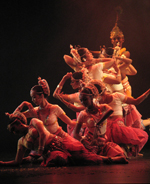

 Alarippu to Moksha 2009
Alarippu to Moksha 2009
13 May 2009, MTC Theatre, Jln Ampang
Sutra Dance Theatre
Big changes are going on at Sutra Dance Theatre. January Low is leaving to spread her wings elsewhere, starting with a 5-month residency in South Korea. With her exit comes a whole new era for Sutra, and Alarippu to Moksha, Sutra’s regular performance which serves as a launching pad for student dancers, was a good opportunity to check out the shape of things to come.
Certainly January is leaving some big shoes to fill. In a performance at the Singapore Dance Festival last year, January described how she feels that the Indian classical dance form is infused into her body. She is familiar with all its guises, its most subtle sensibilities as well as its most extravagant displays. This was evident in her performance on Wednesday night – she appeared to be enjoying herself immensely, freeing herself to happily inhabit the movement as I have not seen her do in a long while. In the sinuous phrases of ‘Saberi Pallavi’, it was delightful to watch her in one-legged poses, slowly deepening the bend in her supporting leg until it looked as if she could go no more, and then, with exquisite timing, launching into the next movement. And there was particular poignancy in her later portrayal of Krishna’s lover, when moments before she had been in tears as Ramli Ibrahim acknowledged her great contributions to Sutra and her art.
January’s absolute sense of comfort with the Odissi technique is one to which only very experienced dancers may subscribe, and the junior group who performed in the first few numbers on Wednesday night have yet to attain it. They also have a long way to go in developing focus and maturity on stage, but they are young, and their coltish awkwardness is both forgiveable and endearing.
As for the senior dancers, their relative strengths were on parade in Ashta Nayika, in which they illustrated the various dramatic situations experienced in the eternal romance between mortal and god. Divya shows a pleasant abishegam, and a light graceful movement in her arms, but there is something a little unformed about her. She may yet grow into greater strength. Tan Mei Mei is very capable; her agony as the jilted lover was strongly performed, but perhaps too businesslike. Sivagamavalli and Geethika Sree were charmingly well matched in their flower-picking scene, and Sivagamavalli’s following solo was very expressive and watchable. Nishah Devi was perhaps a little too convincing as the pouting ‘little wifey’ to Harenthiran’s lover, but she is clearly a force behind the scenes in arranging works and rehearsing the younger dancers, and this is an important role that should not be overlooked. Revathi has the greatest capacity as a performer. She was quite fetching in her rejection of her lover, rejecting his token and slamming the door on him with spirited grace. In her opening duet with Harenthiran, the lines of her positions were lovely and she absolutely radiated serenity. But she is a small-bodied dancer, and her presence is naturally quieter – its delicacy can be eclipsed by the extrovertism of the other girls.
And then there’s Rathimalar Govindarajoo, who has returned to dance with Sutra in the last few years, after five years in London with Shobana Jeyasingh Dance Company. Being Rathi’s close friend, I sometimes forget how virtuosic she can be. In the piece ‘Ashta Shambu’, depicting the attributes of Shiva and eulogising His triumphs, the audience was in no doubt that they were in the presence of a seasoned performer. Rathi is proficient in varied roles, but she particularly shines in the gruesome and bloodthirsty Shiva dances, when she accesses a great sense of darkness and power. When, as Shiva, she looses an arrow from her bow, it is a full-bodied gut-wrenching movement. She stomps upon her enemies, and claims her kills – you can almost see the corpses piled up around her. Then, as the worshiper, her pivoting turns with arms raised above her head, fists opening and closing, are distinct from the other dancers in her épaulement, spine and shoulders spiralling in ecstatic fervour.
But Rathimalar has been branching into her own choreography, and performing outside of Sutra Dance Theatre, so it is unrealistic to expect her to direct Sutra’s future. I think the responsibility lies with the other senior dancers as a group, rather than as individuals. As individuals, none of them are as versatile as January Low, but the combination of their strengths is formidable. In the final Moksha there was a single magical moment, a sense of real excitement, when the senior dancers stormed the stage and joyfully launched into the rhythm, the junior dancers parting in their path like a school of startled fish. If, after January’s exit, the senior dancers can collectively harness this energy, then Sutra Dance Company can only go from strength to strength.
(BH)
No comments yet.
Sorry, the comment form is closed at this time.